中国历史文化概况(英文版)Unit (10)
中国历史文化概况(英文版)Unit 10 Chinese Cuisine, Tea and Medi
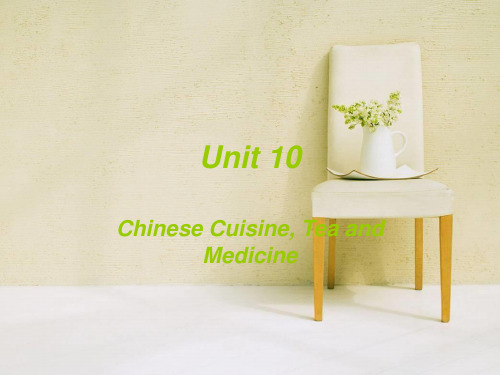
Taiwan Cuisine
• A hundred miles from the Chinese mainland lies Taiwan. Most simply described, the cuisine of this mountainous island on the edge of the Pacific is Chinese, with some significant Japanese influences. Apart from the staple, rice, Taiwan is a bounty of fruit, vegetables, and seafood.
Cantonese Cuisine
• Yue Cuisine, namely Guangdong flavor dishes, is one of the four Chinese cuisines. It enjoys extremely good reputation at home and abroad for its unique types of dishes and special charm.
Hong Kong
• Known as the Oriental Pearl, Hong Kong remains as one of the most traveled places in all of Asia, with its splendid natural beauty and man-made wonders. To get a break from your busy tours in the city, visit a local teahouse.
Teahouses in Taipai are said to be the most typical of Chinese teahouses. It is quite a comfortable thing to sit in a local teahouse and drink a cup of oolong tea or the Pearl Milk Tea like what locals do.
中国文化英语教程Unit10讲述资料
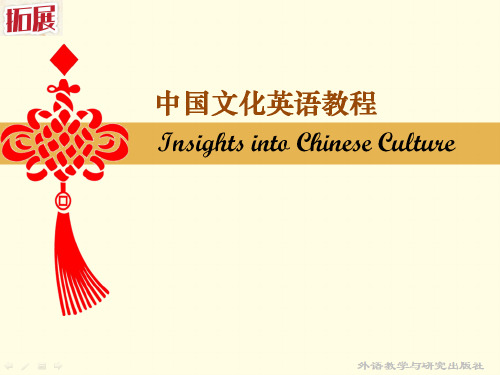
Aspiration for Peace
The Great Wall is unparalleled in the world in:
➢ Scale ➢ Span of construction ➢ Great quantities of labor ➢ Degree of difficulty
Aspiration for Peace
Introduction
• Three major renovations (修复) of the Great Wall took place in the Qin (221-206 BC), Han (206 BCAD 220), and Ming dynasties.
• The eat Wall of today is mainly the legacy of the Ming-dynasty renovations.
Aspiration for Peace
We can see the military defense of the Great Wall from the following sentences:
“北筑长城而守藩篱,却匈奴七百余里,胡人不敢南下而牧马。” ——《新书·过秦》
“建塞徼、起亭燧、筑外城,设屯戍以守之,然后边境得用少安。” ——《汉书·匈奴传》
中国文化英语教程Unit10讲述资料

“筑长城,自代并阴山下,至高阙为塞”
——《史记·匈奴列传》
Aspiration for Peace
Protection for the southerners from being attacked by the northerners
• The Great Wall prevented northern peoples on horseback from attacking people in the south who were mostly engaged in farming.
“Seen from today, if it had not been for the protection of the Great Wall, Chinese civilization would have been interrupted by the northern peoples in the late Qin or early Han dynasties, long before the Song and Ming dynasties. In that case, there would not have been the prosperity of the Han and Tang dynasties, or the integration of southern and northern peoples.”
Why did the Chinese build the Great Wall? • Military defense in the age of cold steel • Protection for the southerners from being
attacked by the northerners
中国文化英语教程Unit-11
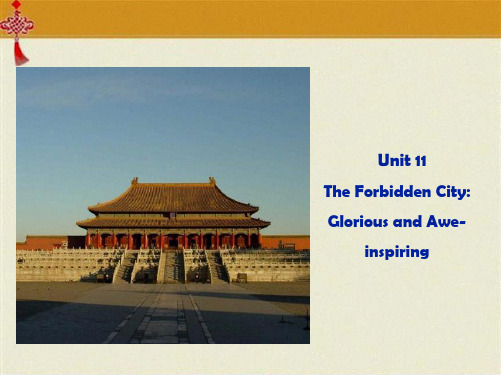
Concealed Contours of a Dragon
A bird’s-eye view of the central axis design
Concealed Contours of a Dragon
• The axis starts from the Gate of Eternal Stability (永定门) in the south.
• To the west of Tian’anmen is the Imperial State Shrine (社 稷坛), which has become Sun Yat-sen Park today.
Concealed Contours of a Dragon
• Through the Gate of Uprightness (端门) and then the Meridian Gate ( 午门), the central axis passes into the Forbidden City, and extends all the way to its northern gate, Gate of Divine Might (神武门).
• Further north to Prospect Hill is the Gate of Earthly Peace (地安门
). From there a straight boulevard leads to the Drum Tower and the Bell Tower, which mark the northern end of the central axis of ancient Beijing.
• The Outer Court is where the emperor ran state affairs.
china's history中国历史英文版
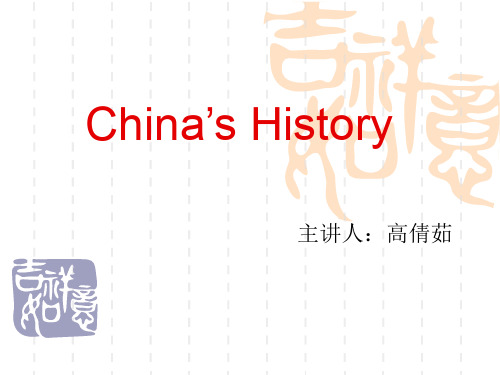
Yao, Shun and Yu
The Origin of Chinese Culture
Generally speaking, Chinese civilization, as one of the independent civilization sources, has a clear evolutionary track, indicating a diversified development with the central plain as the core and resulting in the feature of mutual penetration and integration.
The Spring & Autumn and Warring States Periods The seven states in the Warring States Period The States of Qi The States of Chu The States of Yan The States of Han The States of Wei The States of Zhao The States of Qin
Sui Dynasty
Zhaozhou Bridge in Hebei, built in the Sui Dynasty, is the earliest single-arch stone bridge wellreserved in the world.
Tang Dynasties
The first emperor
Buddhist monk Jian Zhen from Japan came to Tang Dynasty spread Buddhism.
中国文化概况(English)英语版
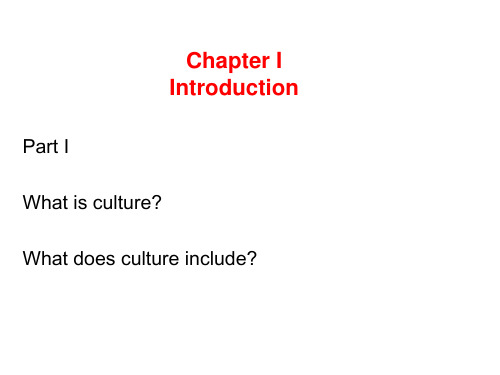
Agriculture as Economic Foundation
a farmer’s life is relatively fixed, settled, and relaxingly permanent---"the lack of mobility." (be free from risk and adventure; conservatism)
Farming was the major mode of production and family, the basic unit.
e.g: encouraging farming but limiting commerce, worship the land, fear for the heaven and the earth,
On Human Nature
Mencius
“人无有不善,水无有不下。”
“human nature is originally good”
Xunzi
“人之性恶,其善者伪也。”
“human nature is originally evil”
Imperial Confucianism--- Dong Zhongshu
Yuannan-Guizhou mountainous region; tropical rain forest
ocean
Influence: To provide natural advantages for Chinese culture
1) to develop independently 2) be free from the impact of foreign cultures Thus, Chinese culture is relatively stable , independent and distinctive.
中国文化英语教程 unit10 confucius
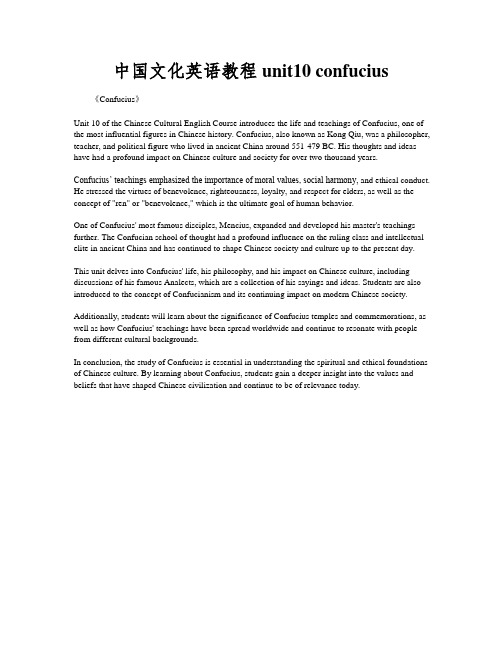
中国文化英语教程 unit10 confucius 《Confucius》Unit 10 of the Chinese Cultural English Course introduces the life and teachings of Confucius, one of the most influential figures in Chinese history. Confucius, also known as Kong Qiu, was a philosopher, teacher, and political figure who lived in ancient China around 551-479 BC. His thoughts and ideas have had a profound impact on Chinese culture and society for over two thousand years.Confucius’ teachings emphasized the importance of moral values, social harmony, and ethical conduct. He stressed the virtues of benevolence, righteousness, loyalty, and respect for elders, as well as the concept of "ren" or "benevolence," which is the ultimate goal of human behavior.One of Confucius' most famous disciples, Mencius, expanded and developed his master's teachings further. The Confucian school of thought had a profound influence on the ruling class and intellectual elite in ancient China and has continued to shape Chinese society and culture up to the present day. This unit delves into Confucius' life, his philosophy, and his impact on Chinese culture, including discussions of his famous Analects, which are a collection of his sayings and ideas. Students are also introduced to the concept of Confucianism and its continuing impact on modern Chinese society.Additionally, students will learn about the significance of Confucius temples and commemorations, as well as how Confucius' teachings have been spread worldwide and continue to resonate with people from different cultural backgrounds.In conclusion, the study of Confucius is essential in understanding the spiritual and ethical foundations of Chinese culture. By learning about Confucius, students gain a deeper insight into the values and beliefs that have shaped Chinese civilization and continue to be of relevance today.。
中国历史简介英文(16页)
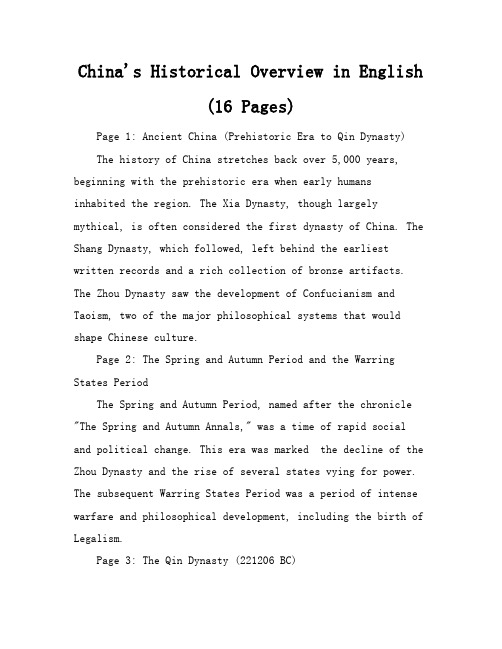
China's Historical Overview in English(16 Pages)Page 1: Ancient China (Prehistoric Era to Qin Dynasty)The history of China stretches back over 5,000 years, beginning with the prehistoric era when early humansinhabited the region. The Xia Dynasty, though largely mythical, is often considered the first dynasty of China. The Shang Dynasty, which followed, left behind the earliest written records and a rich collection of bronze artifacts. The Zhou Dynasty saw the development of Confucianism and Taoism, two of the major philosophical systems that would shape Chinese culture.Page 2: The Spring and Autumn Period and the Warring States PeriodThe Spring and Autumn Period, named after the chronicle "The Spring and Autumn Annals," was a time of rapid social and political change. This era was marked the decline of the Zhou Dynasty and the rise of several states vying for power. The subsequent Warring States Period was a period of intense warfare and philosophical development, including the birth of Legalism.Page 3: The Qin Dynasty (221206 BC)The Qin Dynasty, though shortlived, was pivotal in Chinese history. Qin Shi Huang, the first emperor of aunified China, standardized the writing system, currency, and measurements. He also began construction of the Great Wall and the Terracotta Army, which continues to astound visitors today.Page 4: The Han Dynasty (206 BC AD 220)The Han Dynasty is often cited as one of the golden ages of Chinese history. It saw the expansion of the Silk Road, which facilitated trade and cultural exchange with the West. The Han Dynasty also saw the development of Buddhism in China and the establishment of a civil service system based on merit.Page 5: The Three Kingdoms, Jin Dynasty, and the Southern and Northern DynastiesThe Three Kingdoms period, romanticized in the historical novel "Romance of the Three Kingdoms," was a time of fragmentation and warfare following the fall of the Han Dynasty. The Jin Dynasty reunified the north, but the country soon split again into the Southern and Northern Dynasties, leading to a period of cultural diversity and technological innovation.Page 6: The Sui Dynasty (581618)The Sui Dynasty, though shortlived, managed to reunify China. It is known for the construction of the Grand Canal, which linked the Yellow River and the Yangtze River, facilitating trade and transportation across the vast territory.Page 7: The Tang Dynasty (618907)The Tang Dynasty is renowned for its cultural achievements and economic prosperity. It is often referred to as the "Age of Unity andProsperity." The Tang Dynasty saw the flourishing of poetry, with poets like Li Bai and Du Fu, and the expansion of foreign trade along the Silk Road.Page 8: The Five Dynasties and Ten Kingdoms Period (907960)The Five Dynasties and Ten Kingdoms period was a time of political fragmentation. Despite the lack of a central authority, this era saw the continuation of cultural and economic developments, particularly in the south.(To be continued)Page 9: The Song Dynasty (9601279)The Song Dynasty is celebrated for its economicrevolution and cultural advancements. The era saw the early development of a market economy, the introduction of paper money, and remarkable innovations in agriculture and technology. The Song Dynasty also nurtured a flourishing ofthe arts, with landscape painting reaching new heights andthe philosophical school of NeoConfucianism gaining prominence.Page 10: The Yuan Dynasty (12711368)Established the Mongolian leader Kublai Khan, the Yuan Dynasty marked the first time that all of China was ruled nonHan Chinese. The Yuan Dynasty is notable for its patronage of the arts and its administrative organization, whichincluded the establishment of the Yuan Shikai, a precursor to modernday postal systems.Page 11: The Ming Dynasty (13681644)The Ming Dynasty is renowned for its maritime expeditions, notably those led the explorer Zheng He, which reached asfar as Africa and the Middle East. The dynasty is also famous for its architectural achievements, including theconstruction of the Forbidden City and the reinforcement ofthe Great Wall. The Ming era saw a flourishing of literature and drama, with the latter exemplified the works of Tang Xianzu.Page 12: The Qing Dynasty (16441912)The Qing Dynasty, established the Manchu people, was the last imperial dynasty of China. It reached its territorial zenith under Emperors Kangxi and Qianlong, expanding China's borders to include Tibet, Xinjiang, and Mongolia. However,the latter part of the dynasty was marked internal strife, foreign invasions, and the humiliating Boxer Protocol, leading to the decline of imperial power.Page 13: The Xinhai Revolution and the Republic of China The Xinhai Revolution of 1911 led to the overthrow of the Qing Dynasty and the establishment of the Republic of China under the leadership of Sun Yatsen. The early years of the republic were tumultuous, with warlordism and the strugglefor power between the Nationalist Party (Kuomintang) and the Communist Party.Page 14: The Chinese Civil War and the Establishment of the People's Republic of ChinaThe Chinese Civil War, which began in the late 1920s and ended in 1949, resulted in the victory of the Communist Party and the establishment of the People's Republic of China Mao Zedong. The new regime implemented sweeping land reforms and began the process of collectivization, which would have profound effects on Chinese society.Page 15: The Cultural Revolution and its AftermathThe Cultural Revolution, initiated Mao Zedong in 1966, was a radical sociopolitical movement aimed at purging remnants of capitalist and traditional elements from Chinese society. It led to widespread violence and the destruction of historical artifacts. The period following the CulturalRevolution was marked a shift towards economic reform and opening up to the world.Page 16: Modern China and the Path to the FuturePage 17: The Reform and Openingup PolicyDeng Xiaoping's leadership in the late 1970s brought about the Reform and Openingup Policy, which transformed China's economy from a centrally planned system to a market economy. This policy allowed foreign investment, established special economic zones, and encouraged private enterprise. The result was an economic boom that lifted hundreds of millions out of poverty and turned China into a global manufacturing hub.Page 18: The Rise of China's Tech GiantsPage 19: China's Space ExplorationChina's space program has made significant strides, including the successful launch of the Shenzhou spacecraft series and the construction of the Tiangong Space Station. In 2020, China became the second country to land a rover on the far side of the moon, demonstrating its ambition and capability in space exploration.Page 20: Environmental Challenges and Green InitiativesPage 21: Belt and Road InitiativeAnnounced in 2013, the Belt and Road Initiative is a global development strategy aimed at enhancing regionalconnectivity and economic integration. It involves infrastructure development and investments in countries across Asia, Europe, and Africa. The initiative reflects China's desire to take a more active role in global affairs and to expand its influence.Page 22: China's Role in Global DiplomacyChina has increasingly engaged in global diplomacy, playing a key role in international organizations such as the United Nations. It has also established strategic partnerships with countries around the world. However,China's assertiveness in regional disputes, particularly in the South China Sea, has raised concerns about its geopolitical intentions.Page 23: The Pursuit of Soft PowerRecognizing the importance of soft power, China has been promoting its culture and language through initiatives like the establishment of Confucius Institutes worldwide. These institutes offer Chinese language and cultural courses, contributing to the global spread of Chinese language and culture.Page 24: ConclusionChina's history is a tapestry of dynasties, revolutions, and rapid modernization. From the ancient dynasties that laid the foundation for Chinese civilization to the modern era oftechnological advancement and global engagement, China's story is one of resilience, innovation, and transformation. As China continues to evolve, its historical narrative will no doubt continue to influence its role on the world stage.。
中国历史文化概况(英文版)Unit 8 Traditional Holidays and Celeb
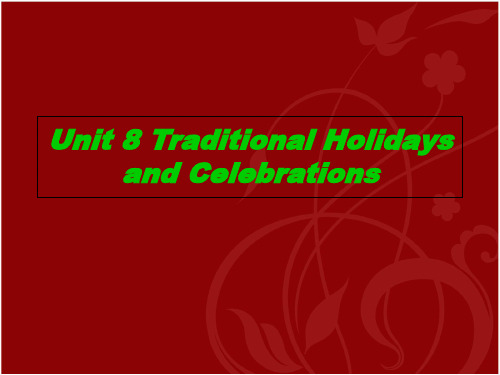
The time of the Mid-Autumn Festival
• The 15th day of every 8th lunar month is the traditional Chinese Mid-Autumn Festival. It is the most important festival after the Chinese Lunar New Year. The moon on the night of the 15th day of lunar August is believed to be fuller and brighter than in other months.
Staying up the whole night
on New Year's Eve
• Legend has it that in ancient times, there was a monster called "nian" or "year" that would harm people. Later, people found out that the monster routinely came out on New Year's Eve, so people began to get together on this day, staying up and chatting, hoping for peaceful passage of the time. The custom of staying up on New Year's Eve started in the South and North Dynasties, when people would stay up by the candle or oil lamp on New Year's Eve. The custom symbolizes the warding off of all diseases and disasters, wishing for good luck in the New Year.
中国历史简介英语
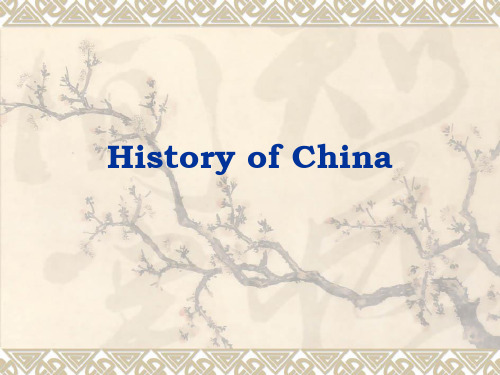
Brief introduction of Chinese history
❖ The Tang Dynasty(618~ 907) is very famous in the world, and very powerful and rich.
❖ It has two capital, Xian and Luoyang.
Why?
3. Something about Diaoyu Islands
Preface: We have a big family
❖ 1. China has a land area of 9.6 millions square kilometers, making it the thirdbiggest country in the world.
800 Population/million
600 400 200
0
Time
夏Xia 商Shang 西周Xizhou 东周Dongzhou
秦Qin 西汉Xihan 东汉Donghan 三国Sanguo
晋Jin 十六国 南北朝 唐Tang 五代十国 宋Song 元Yuan 明Ming 清Qing 中华民国China China1949 China1988 China2004
❖ Hundreds of thousands of people are killde in the war.
Brief introduction of Chinese history
❖ The Jin Dynasty unified the whole country in 265, established it’s capital in Luoyang, called East Jin Dynasty.
中国历史文化概况(英文版)Unit (14)

TEXT A
•
ห้องสมุดไป่ตู้
Reading Comprehension
•
•
•
Decide whether the following statements are true (T) or false (F) according to the passage. 1. The Summer Palace occupies a total area of 290 hectares, most of which is made up of shallow lakes. ( ) 2. The first act of destruction took place in 1860 when the Anglo-French forces invaded Beijing and ravaged only the Yuanmingyuan Garden. ( ) 3. The three Chinese characters of the name of the Summer Palace "Yiheyuan" have been inscribed in Emperor Jiaxing's hand. ( )
Architecture.
3. Master the difficult words and expressions.
Text A
Summer Palace (Yiheyuan) (Excerpts)
TEXT A
Preview
颐和园是中国现存规模最大、保存最完整的皇家园林,中国四 大名园(另三座为承德避暑山庄、苏州拙政园、苏州留园)之 一。位于北京市海淀区,距北京城区十五公里,占地约二百九 十公顷。利用昆明湖、万寿山为基址,以杭州西湖风景为蓝本, 汲取江南园林的某些设计手法和意境而建成的一座大型天然山 水园,也是保存得最完整的一座皇家行宫御苑,被誉为皇家园 林博物馆。
中国历史文化概况(英文版)Unit (15)

CONTENTS
Teaching Aims Text A
Text B Supplementing Reading
TEACHING AIMS
After studying this unit, you are required to: 1. Have a general idea of Reform and Development. 2. Understand the history of Chinese Reform and Development. 3. Master the difficult words and expressions.
Text A
Expo 2010 Shanghai China
TEXT A
Preview
中国2010年上海世界博览会(Expo 2010),是第41届世界博览 会。于2010年5月1日至10月31日期间,在中国上海市举行。此 次世博会也是由中国举办的首届世界博览会。上海世博会以 “城市,让生活更美好”(Better City, Better Life)为主 题,总投资达450亿人民币,创造了世界博览会史上最大规模记 录。同时超越7000万的参观人数也创下了历届世博之最。
TEXT A
Notes
It had the largest number of countries participating and was the most expensive Expo in the history of the world's fairs. The Shanghai World Expo was also the largest World's Fair site ever at 5.28 square km. By the end of the expo, over 73 million people had visited – a record attendance – and 250 countries and international organizations had participated. On 16 October 2010, the expo set a single-day record of having over 1.03 million visitors enter the exhibition that day.
中国文化概况英汉对照版
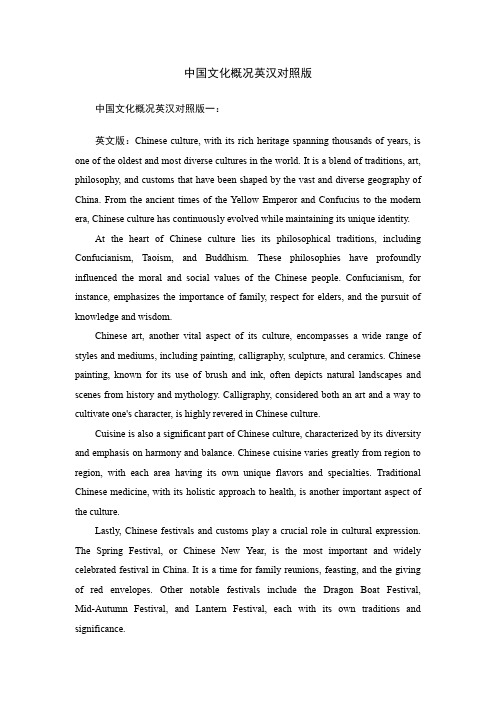
中国文化概况英汉对照版中国文化概况英汉对照版一:英文版:Chinese culture, with its rich heritage spanning thousands of years, is one of the oldest and most diverse cultures in the world. It is a blend of traditions, art, philosophy, and customs that have been shaped by the vast and diverse geography of China. From the ancient times of the Yellow Emperor and Confucius to the modern era, Chinese culture has continuously evolved while maintaining its unique identity.At the heart of Chinese culture lies its philosophical traditions, including Confucianism, Taoism, and Buddhism. These philosophies have profoundly influenced the moral and social values of the Chinese people. Confucianism, for instance, emphasizes the importance of family, respect for elders, and the pursuit of knowledge and wisdom.Chinese art, another vital aspect of its culture, encompasses a wide range of styles and mediums, including painting, calligraphy, sculpture, and ceramics. Chinese painting, known for its use of brush and ink, often depicts natural landscapes and scenes from history and mythology. Calligraphy, considered both an art and a way to cultivate one's character, is highly revered in Chinese culture.Cuisine is also a significant part of Chinese culture, characterized by its diversity and emphasis on harmony and balance. Chinese cuisine varies greatly from region to region, with each area having its own unique flavors and specialties. Traditional Chinese medicine, with its holistic approach to health, is another important aspect of the culture.Lastly, Chinese festivals and customs play a crucial role in cultural expression. The Spring Festival, or Chinese New Year, is the most important and widely celebrated festival in China. It is a time for family reunions, feasting, and the giving of red envelopes. Other notable festivals include the Dragon Boat Festival, Mid-Autumn Festival, and Lantern Festival, each with its own traditions and significance.汉语对照版:中国文化,拥有数千年的丰富遗产,是世界上最古老、最多样化的文化之一。
中国历史文化概况(英文版)Unit-10-Chinese-Cuisine--Tea-and-Medi
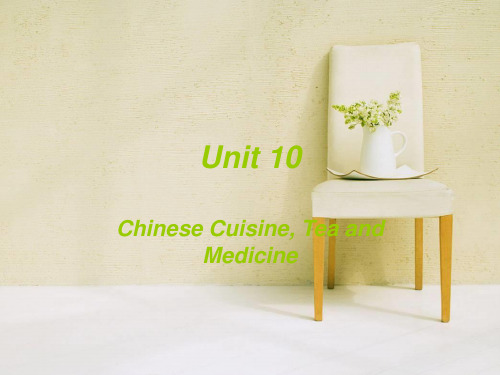
• Located along the southern coast of China, Guangdong abounds with food of animal and plant sources. At the same time, Guangzhou has been a long-standing treaty port city, which attracted and absorbed various foreign cooking materials and techniques. And thus Yue Cuisine was gradually perfected. In addition, overseas Chinese brought the cooking techniques from Europe, America and Southeast Asia back to their hometown and accordingly enriched the recipes of Yue Cuisine. There are very obvious traces of Western cooking techniques in Yue Cuisine.
Sichuan Cuisine
中国历史文化概况(英文版)Unit (11)

Despite the government’s enthusiastic support, Beijing Opera today is encountering serious problems. Competition from films, TV dramas and popular music led to a decrease of its audiences and consequently in box-officer avenue. As a result, Beijing Opera troupes, like other traditional Chinese opera troupes, cannot afford to put on new plays and train new performers.
The characters in Beijing Opera are usually divided into four types: sheng, dan, jing and chou, each has a style and rule to fits its own.
The facial make-up is a unique and fascinating aspect Beijing Opera, revealing the personality, status, age and abilities of various characters in an exaggerated form. The facial make-up is said to have originated from masks with which the ancient warriors went to war to scare away the enemy. As opera plots and characters became more complex and involved, the masks were found to be inadequate, and were replaced by direct face painting.
中国文化概况中英版
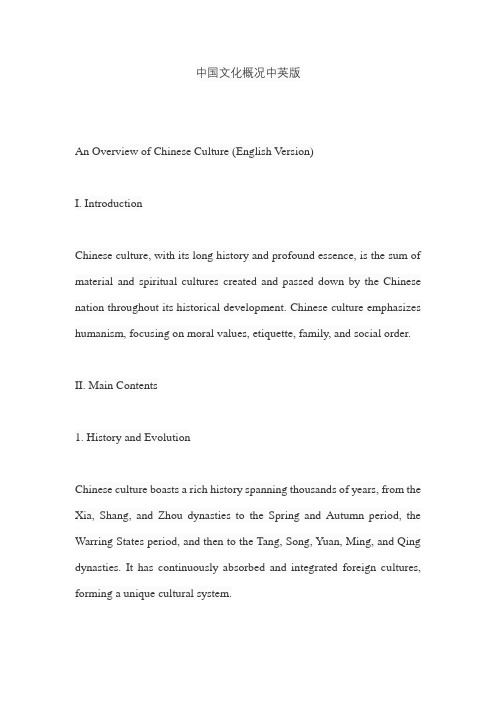
中国文化概况中英版An Overview of Chinese Culture (English Version)I. IntroductionChinese culture, with its long history and profound essence, is the sum of material and spiritual cultures created and passed down by the Chinese nation throughout its historical development. Chinese culture emphasizes humanism, focusing on moral values, etiquette, family, and social order.II. Main Contents1. History and EvolutionChinese culture boasts a rich history spanning thousands of years, from the Xia, Shang, and Zhou dynasties to the Spring and Autumn period, the Warring States period, and then to the Tang, Song, Yuan, Ming, and Qing dynasties. It has continuously absorbed and integrated foreign cultures, forming a unique cultural system.2. Traditional ValuesConfucianism is one of the cornerstones of Chinese culture, emphasizing virtues such as benevolence, filial piety, loyalty, and etiquette, which have profoundly influenced the behavior and values of the Chinese people. Taoism emphasizes the harmony between man and nature, advocating a natural and non-interventionist approach. Buddhism, on the other hand, emphasizes compassion and self-sacrifice, having a significant impact on Chinese religion and philosophy.3. Cultural Characteristics- Festival Culture: China has many traditional festivals, such as the Spring Festival, Mid-Autumn Festival, and Dragon Boat Festival, each with unique celebration methods and cultural connotations.- Clothing Culture: Traditional Chinese clothing, such as Hanfu and Tangzhuang, reflects the unique aesthetic concepts and cultural characteristics of the Chinese nation.- Architectural Culture: Traditional Chinese architecture, including palaces, temples, and gardens, is renowned for its distinctive styles and exquisite craftsmanship.- Cuisine Culture: Chinese cuisine, known for its rich flavors and exquisiteculinary techniques, is an important representation of China's cultural charm.4. Influence on the WorldThe values and ideological systems of Chinese culture have had a profound impact on the world, especially Confucianism, which has influenced Asia and beyond. Traditional Chinese arts and forms of expression, such as calligraphy, painting, and Peking Opera, are also deeply loved and admired by people around the world.III. ConclusionChinese culture is a treasure of the Chinese nation, embodying unique charm and value. Through learning and understanding Chinese culture, we can gain a deeper understanding of the history, traditions, and spiritual outlook of the Chinese people, further enhancing our sense of national pride and self-confidence. At the same time, Chinese culture has also made significant contributions to the diversity and development of world culture.中国文化概况中英版一、引言中国文化,源远流长,博大精深,是中华民族在长期历史发展过程中所创造并传承下来的物质文化和精神文化的总和。
中国历史文化概况(英文版)Unit 1 Origins and History

2. The Longshan culture (龙山文化) : a late Neolithic culture in China, centered on the central and lower Yellow River and dated from about 3000 BC to 2000 BC. The Longshan culture is named after the town of Longshan in the east of the area under the administration of the city of Jinan, Shandong Province, where the first archaeological find (in 1928) and excavation (in 1930 and 1931) of this culture took place at the Chengziya Archaeological Site.
5. Mencius (孟子) : an itinerant Chinese philosopher and sage, and one of the principal interpreters of Confucianism. Supposedly, he was a pupil of Confucius' grandson, Zisi. Like Cotravelled China for forty years to offer advice to rulers for reform. During the Warring States Period, Mencius served as an official and scholar at the Jixia Academy in the State of Qi. He expressed his filial devotion when he took an absence of three years from his official duties for Qi to mourn his mother's death. Disappointed at his failure to affect changes in his contemporary world, he retired from public life.
- 1、下载文档前请自行甄别文档内容的完整性,平台不提供额外的编辑、内容补充、找答案等附加服务。
- 2、"仅部分预览"的文档,不可在线预览部分如存在完整性等问题,可反馈申请退款(可完整预览的文档不适用该条件!)。
- 3、如文档侵犯您的权益,请联系客服反馈,我们会尽快为您处理(人工客服工作时间:9:00-18:30)。
Benbang Cuisine
• Shanghai cuisine is the youngest among the ten major cuisines in China though with a history of more than 400 years. Traditionally called Benbang cuisine, it originated in the Ming and Qing Dynasties (1368-1840). Shanghai dishes usually look red and shiny, for they are often pickled in wine and their cooking methods include baking, stewing, teaming, deep-frying, etc. In the later part of 19th century after Shanghai became a major domestic and international trading port,Benbangdishes underwent some substantial changes by adopting certain merits of other cuisines. It formed a complex flavor structure, cooking style and technique norms. It stresses on using condiments and keeping the original flavors of the materials and has features of being fresh, smooth and crispy. Shanghai Dishes aim at lightness in flavor, and beautifulness in decoration.
Lu Cusine
• Lu Cuisine refers to Shangdong dishes, featuring dense taste and favor of shallot and garlic, especially apt at the cooking of seafood, soup and a variety of bowels. Famousraised boneless chicken, braised intestines in brown sauce, and braised Yellow River carp with sweet and sour taste.
Cantonese Cuisine
• Yue Cuisine, namely Guangdong flavor dishes, is one of the four Chinese cuisines. It enjoys extremely good reputation at home and abroad for its unique types of dishes and special charm.
• Located along the southern coast of China, Guangdong abounds with food of animal and plant sources. At the same time, Guangzhou has been a long-standing treaty port city, which attracted and absorbed various foreign cooking materials and techniques. And thus Yue Cuisine was gradually perfected. In addition, overseas Chinese brought the cooking techniques from Europe, America and Southeast Asia back to their hometown and accordingly enriched the recipes of Yue Cuisine. There are very obvious traces of Western cooking techniques in Yue Cuisine.
Sichuan Cuisine
• Sichuan cuisine enjoys a time-honored history and is well-reputed home and abroad. Represented by the local dishes of Chengdu and Chongqing, Sichuan cuisine is particular about ingredients, unified in standard, distinctive in arrangement, and vivid in coordination. Sichuan cuisine features spicy, tongue-numbing, savory, delicious, oily and heavily seasoned flavor, using a lot of capsicum, prickly ash, pepper as well as fresh ginger. From high-class banquet to ordinary meal, from street snack to home-made dishes, Sichuan cuisines is diversified in variety, novel in style, and elaborate in cooking.
Unit 10
Chinese Cuisine, Tea and Medicine
Contents
• Brief introduction about some famous Chinese cuisines
• Chinese Tea culture
Famous Chinese Cuisines
• Lu Cuisine • Sichuan Cuisine • Cantonese Cuisine • Min Cuisine • Benbang Cuisine • Taiwan Cuisine
Min Cuisine
• Min Cuisine, one of the Eight Cuisines of China, is mainly represented by dishes of Fuzhou and Xiamen styles. The dishes of Xiamen style are of strong local flavor of southern Fujian, which feature light soup and flavor, crisp stir-fried dish, and excellent seafood cooking techniques.
